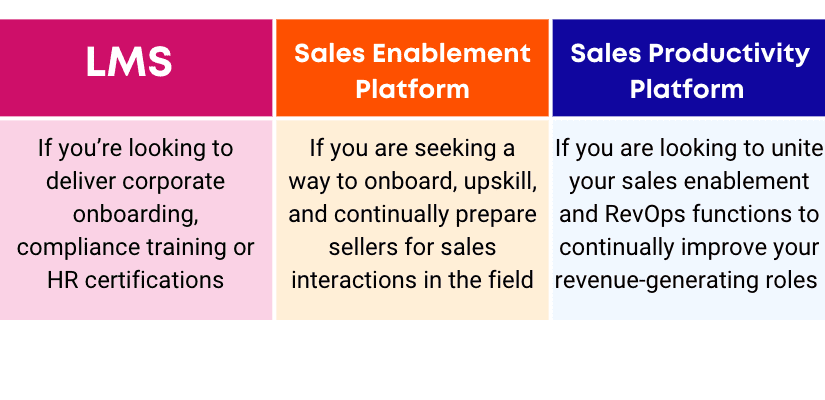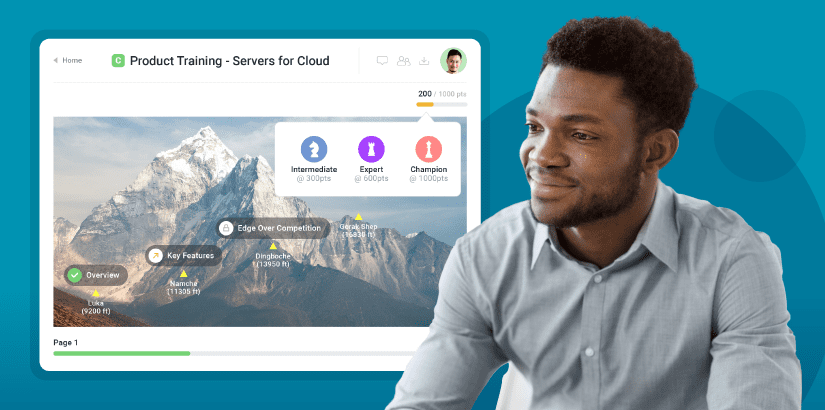LMS vs. Sales Enablement Platform vs. Sales Productivity Platform: What’s the Difference?
![]() Helen Waite
on
April 6, 2023
Helen Waite
on
April 6, 2023
If you’re in the market for a solution to train your sales teams to peak productivity, there are probably a few different options that keep coming up in your searches: sales enablement platform, sales productivity platform, and learning management system (LMS).
While these three distinct product categories share similarities in how they deliver training, there are key differences and objectives they set out to achieve for organizations.
First, let’s take a look at a basic definition of each.
Learning Management System (LMS)
A Learning Management System (LMS) is a software application that allows organizations to create, manage, and deliver online training programs to their employees. LMSs typically include features such as course creation, tracking and reporting, and certification management. These systems are ideal for companies that want to deliver generic training to all employees, like compliance and HR trainings.
Sales enablement platform
A sales enablement platform is a software application that helps sales teams prepare for sales interactions. These platforms typically include features such as training, role-playing simulations, assessments, and coaching tools. Sales enablement platforms are designed to help sales teams develop the skills and knowledge they need to be successful in their roles.
Sales productivity platform
A sales productivity platform is a software application that provides sales teams with the skills, content, tools, and resources they need to be successful. These platforms typically include features in addition to enablement platforms such as content management, conversation intelligence, and revenue intelligence. Sales Productivity Platforms are designed to help sales teams build the knowledge, skills, and behaviors necessary to close more business.
The sales productivity landscape
Historically, the idea of empowering your sales team to succeed started with a one-time sales onboarding program and over time was supported by content (datasheets, recorded demos, whitepapers, etc.) to help reps sell more effectively.
However, as sales processes have evolved and become more complex, the expectation for how to best equip sellers has changed too. It’s not just about one-time training or content anymore — 73% of companies that TOPO recently surveyed have dedicated people within their sales teams focused on training, coaching, content, communications, and more.
One-time training and opportunistic, deal-focused coaching isn’t enough. Successful sales leaders realize that for reps to reach their full potential, they must be supported with always-on, personalized, and data-driven programs.
If you’re searching for a solution to drive sales productivity, invest in a tool that’s fit to handle the needs of a modern (and increasingly complex) selling environment.
In addition to providing ongoing support and training, some other considerations that may influence your needs include:
-
- Keeping an increasingly remote workforce on the same page and regularly updated
-
- Approaching learning in the context and in the moment of need
-
- Retraining, certifying, and ramping up sales and customer-facing teams
-
- Delivering easy-to-consume content in customizable, bite-sized chunks
-
- Enabling safe practice and certifications before money is on the line
-
- Providing insights that tie training to business outcomes
-
- Simplifying and streamlining your tech stack
With these things in mind, how do you go about choosing the right solution?
Finding a solution that suits your needs
The biggest difference between a traditional LMS and the other sales-specific solutions is that an LMS wasn’t built with the unique needs of a constantly evolving sales team in mind.
While an LMS is an ideal solution for HR-led corporate training, its typical focus is on compliance, policies, and procedures, and other generalized corporate programs. Individual sellers may have an array of unique needs, but an LMS is not typically equipped to facilitate the nuanced training or coaching required for most salespeople, nor can an LMS map skill development to business outcomes.
When comparing sales enablement platforms and sales productivity platforms, some significant differences set them apart. Sales enablement platforms focus on the training, practice, and reinforcement of knowledge for sellers while a sales productivity platform is more encompassing of not only tools for enablement professionals but also tools for revenue operations and sales leader professionals. These include conversation intelligence, revenue intelligence, and digital sales rooms.
In the chart below, we’ve highlighted some key areas that differentiate a sales enablement platform from an LMS from a sales readiness platform.
Selecting the right software
Each of these solutions shares some core functionality, but there are essential features that differentiate them. Start by identifying the core problems you are trying to solve, then select a tool that helps you solve those challenges.
If you’re looking to deliver corporate onboarding, compliance training or HR certifications, an LMS will be a good option for your needs.
If you are seeking a way to onboard, upskill, and continually prepare sellers for sales interactions in the field, a sales enablement platform will be a good fit.
If you are looking to unite your sales enablement and RevOps functions to continually improve your revenue-generating roles, a sales productivity platform will help you do just that.

Get teams revenue-ready with Mindtickle’s Sales Productivity Platform
Mindtickle’s revenue productivity platform arms best-in-class organizations with the tools they need to empower enablement, sales leadership, and revenue operations departments. Mindtickle unifies these teams with the combined goal of improving the productivity of revenue-generating roles.
-
- Training and reinforcement to equip salespeople with the knowledge and skills they need to succeed
-
- Practice and role-play exercises to ensure that they’re prepared before money is on the line
-
- Conversation intelligence to capture and analyze real-world conversations
-
- On-the-job coaching aids to help managers and sellers focus on improving the skills that drive productivity
-
- Deal insights and pipeline management for hyper-accurate forecasts
-
- Detailed analytics that scores competencies and exposes individual and team skill gaps, tying readiness activities to business outcomes
The result? Higher win rates, boosted seller productivity, and increased revenue.
This post originally appeared in April 2021 and was re-published in April 2023.


